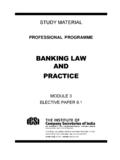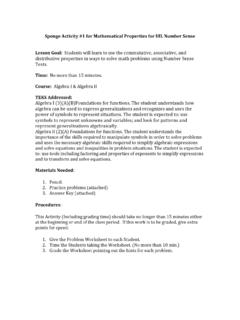Transcription of RESEARCH REPORT 061 - Health and Safety Executive
1 HSE. Health & Safety Executive factoring the human into Safety : Translating RESEARCH into practice Crew Resource Management Training for offshore Operations Volume 3 (of 3). Prepared by the University of Aberdeen for the Health and Safety Executive 2003. RESEARCH REPORT 061. HSE. Health & Safety Executive factoring the human into Safety : Translating RESEARCH into practice Crew resource management training for offshore operations Volume 3 (of 3). Kathryn Mearns, Sean Whitaker, Rhona Flin, Rachael Gordon and Paul O'Connor Industrial Psychology Group University of Aberdeen King's College Aberdeen AB24 3FX.
2 This is Volume 3 of the final REPORT of HSE/JIP project 3661 factoring the Human into Safety ', sponsored by: Agip UK Ltd.; AMEC Process and Energy Ltd; BP Amoco; Coflexip Stena offshore Ltd. Conoco UK Ltd.; Elf Exploration UK; Halliburton Brown and Root; Health and Safety Executive (OSD). Kerr-McGee North Sea Ltd.; Salamis/SGB Ltd.; Transocean Sedco Forex; Shell Expro UK Ltd.; Texaco North Sea UK Ltd; Total Fina. The aim of this workpackage was to design and evaluate a form of human factors training called Crew Resource Management (CRM) which is intended to improve Safety , productivity, and to reduce down time on offshore installations.
3 The course was developed by liasing with CRM developers in other industries, analysing incidents, scrutinising previous human factors RESEARCH in the offshore industry, interviewing people with offshore experience, and talking with onshore management. This REPORT and the work it describes were funded by the HSE. Its contents, including any opinions and/or conclusions expressed, are those of the authors alone and do not necessarily reflect HSE. policy. HSE BOOKS. Crown copyright 2003. First published 2003. ISBN 0 7176 2697 0. All rights reserved. No part of this publication may be reproduced, stored in a retrieval system, or transmitted in any form or by any means (electronic, mechanical, photocopying, recording or otherwise) without the prior written permission of the copyright owner.
4 Applications for reproduction should be made in writing to: Licensing Division, Her Majesty's Stationery Office, St Clements House, 2-16 Colegate, Norwich NR3 1BQ or by e-mail to ii This volume forms the third part of a series of reports for project 3661 : factoring the Human into Safety : Translating RESEARCH into Practice'. Volume 1 of the REPORT is (RR 059/2002) Benchmarking human and organisational factors in offshore Safety ' and Volume 2 of the REPORT is (RR 060/2002) The Development and Evaluation of a Human Factors Accident and Near Miss Reporting Form for the offshore Industry' The overall aim of the project was to develop practical programmes for the offshore oil and gas industry which can lead to.
5 A) A better understanding of human and organisational factors in Safety , b) Continued improvements in Safety management and c) An improved Safety culture' throughout the industry as a whole. In order to achieve this overall objective, three work packages were proposed which build on previous work (see Mearns, Flin, Fleming and Gordon, 1997)). 1. A bench-marking study to identify, analyse and share best practice on human factors Safety -related issues. 2. Systematically analysing for trends in human factors causes of accidents so that the information can be used to develop training programmes for CRM and for training accident investigators.
6 The information could also be used in the bench-marking study. 3. Developing crew resource management (CRM) packages especially for training supervisors and offshore teams in human factors issues. iii iv Acknowledgement We thank the sponsoring company, in particular the Safety Manager on our steering group, the Asset Managers who gave us access, those individuals who helped in the development of the training, and the OIMs and crews who attended the courses. v vi Executive SUMMARY. This is Volume 3 of the final REPORT of HSE/JIP project 3661 factoring the Human into Safety ', sponsored by: Agip UK Ltd.
7 ; AMEC Process and Energy Ltd; BP Amoco; Coflexip Stena offshore Ltd. Conoco UK. Ltd.; Elf Exploration UK; Halliburton Brown and Root; Health and Safety Executive (OSD) Kerr-McGee North Sea Ltd.; Salamis/SGB Ltd.; Transocean Sedco Forex; Shell Expro UK Ltd.; Texaco North Sea UK Ltd; Total Fina. Aim The aim of this workpackage was to design and evaluate a form of human factors training called Crew Resource Management (CRM) which is intended to improve Safety , productivity, and to reduce down time on offshore installations. Development of a CRM course for offshore teams The course was developed by liasing with CRM developers in other industries, analysing incidents, scrutinising previous human factors RESEARCH in the offshore industry, interviewing people with offshore experience, and talking with onshore management.
8 Courses Eight courses were delivered to a cross section of individuals working on five platforms from one operating company (n=104). Evaluation Each course was evaluated by receiving feedback from the participants regarding the content and delivery of the course. Participants' attitudes were evaluated before and after the course using an attitude questionnaire. Also, participants' evaluation of an accident scenario were analysed. The feedback from the courses was generally positive. However, a need to tailor the course further for the offshore environment with more videos and case studies of actual offshore incidents, and to provide more practical tools, and less theory was indicated by the course participants.
9 Vii viii TABLE OF CONTENTS. 1. BACKGROUND ..1. 1. CRM TRAINING IN AVIATION.. 1. What is CRM? .. 1. Does CRM work?.. 2. CRM beyond 3. T HE RATIONALE FOR CRM TRAINING offshore .. 3. CRM TRAINING offshore .. 5. 6. 2. METHOD A: DESIGNING offshore CREW RES OURCE MANAGEMENT LIASING WITH 7. COURSE CONTENT .. 7. COURSE DELIVERY .. 9. Participants ..9. 3. METHOD B: TRAINING 13. M ETHODS OF CRM EVALUATION .. 13..12. Participants'feedback ..13. Participants' 14. 14. 4. 17. COURSE FEEDBACK QUESTIONNAIRE .. 17. RESPONSES TO THE ATTITUDE QUESTIONNAIRE .. 21. ACCIDENT 24. 5. 25. COURSE EVALUATION.
10 25. FURTHER DEVELOPMENT .. 25. 6. CONCLUSION .. 27. 7. BIBLIOGRAPHY .. 29. APPENDIX 1: COURSE EVALUATION 33. ix APPENDIX 2: THE offshore CREW RESOURCE MANAGEMENT 37. APPENDIX 3: ACCIDENT SCENARIOS .. 39. x 1. BACKGROUND. Introduction This REPORT is concerned with the development, application to the offshore oil industry, and evaluation of a type of human factors training which was developed by the aviation industry called Crew Resource Management (CRM). This CRM study is Workpackage 3 of a larger two year HSE joint industry project factoring the Human into Safety ' (Project code D3661) sponsored by: Agip UK Ltd.


















